15 Types of GREY And BLACK BIRDS (ID Guide With Photos)
Did you recently come across a grey and black bird, and want to know what species it was?
Identifying birds that have both grey and black plumage is not as easy as it might seem, since there are surprisingly many birds in North America that fit this description.
To help you identify the bird you saw, we’ll cover all the black and grey birds of North America.

What types of birds are grey and black?
There are 15 types of birds that are grey and black in North America, which are covered in full detail below.
Northern Mockingbird
Scientific name: Mimus polyglottos
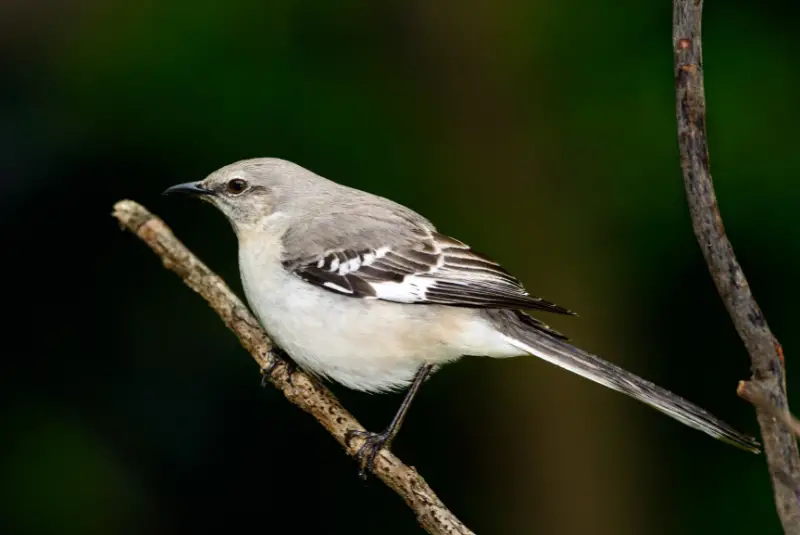
The Northern Mockingbird is a familiar songbird in North America, and its melodious whistling song can be heard in many parts of the state.
Its overall appearance is dark gray, except for its black wings with white stripes, which are especially conspicuous in flight, flashing like bright signals.
Northern Mockingbirds are common backyard birds in North America, with both sexes resembling each other. In addition to the black wings, its tail is also black, and has white margins.
It has a dark eyestripe that contrasts with the yellow eye, while the underparts are buff white. Juvenile birds look similar to adults, but are covered with spots and streaks.
This bird is the only mockingbird species found in North America. It prefers wooded areas as well as urban habitats with sufficient tree growth, such as parks and golf courses.
Gray Catbird
Scientific name: Dumetella carolinensis
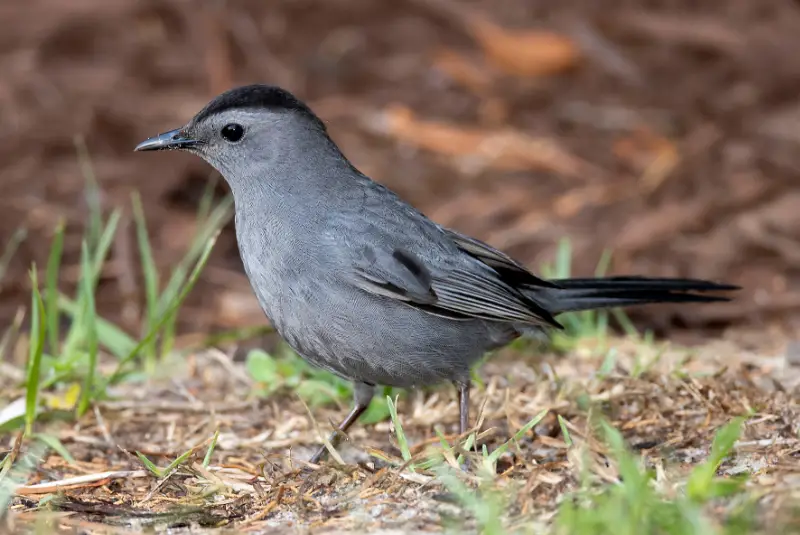
The Gray Catbird is easily recognizable due to its long tail. Both sexes and juveniles look alike and have dark gray body coloration, a black cap and a rufous red undertail.
The Gray Catbird is a common breeding bird in North America, and can be found in forests and scrubland
These small grey birds with black heads like to forage on the ground for insects and berries, and are secretive small birds that are hard to observe.
White-breasted Nuthatch
Scientific name: Sitta carolinensis
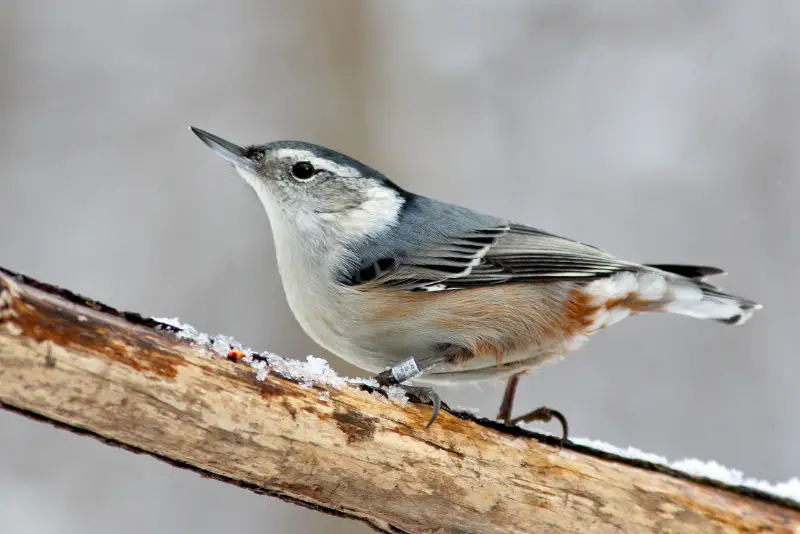
This is the largest Nuthatch species in North America, and is a common year-round resident in large parts of North America.
Adults have a grayish blue back and wings, as well as a white face, throat, and breast.
These small black and grey songbirds favor deciduous or mixed forests, and are common visitors at tube feeders offering sunflower seeds.
Outside of the breeding season White-breasted Nuthatches form small flocks with other species of songbirds, which rove around and forage together.
Carolina Chickadee
Scientific name: Poecile carolinensis
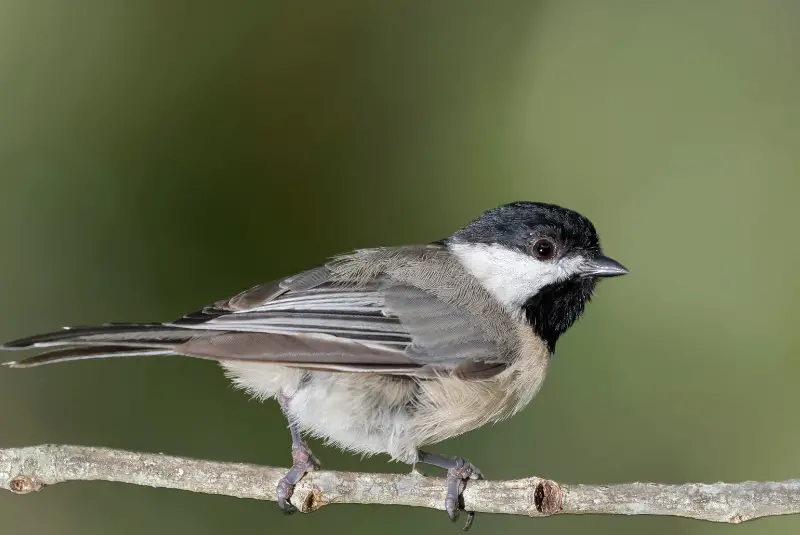
The Carolina Chickadee is easily identifiable by its black cap and bib. Both sexes look similar and have a grayish back and buff white underparts.
Similar to other chickadee species, Carolina Chickadees are small grey birds with black and white striped heads. They are non-migratory birds that nest in deciduous forests of North America.
This black and grey chickadee readily visits backyard feeders, and has a preference for sunflower seeds. It also accepts nest boxes as a substitute for treeholes.
Black-capped Chickadee
Scientific name: Poecile atricapillus
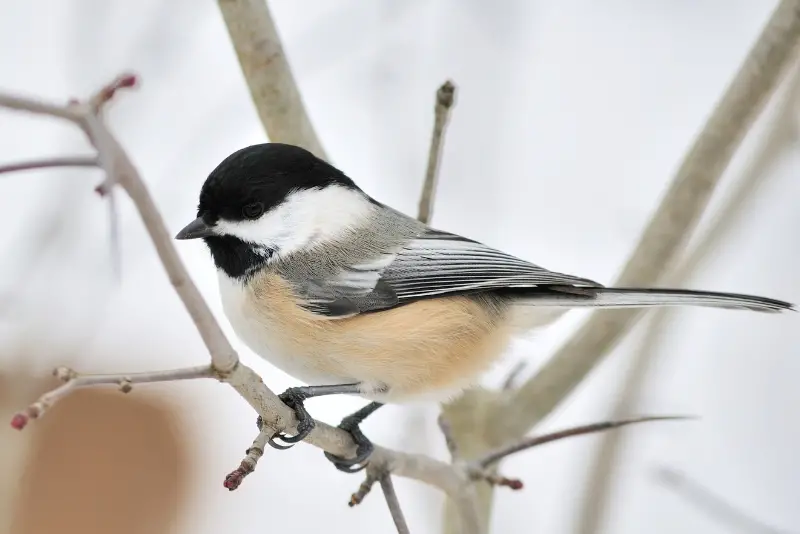
The Black-capped Chickadee is a common bird species in North America. Both sexes look similar, and have gray backs with buff underparts.
Their most distinguishing feature is the black cap and the black bib, which contrasts with the bright white cheeks.
This grey and black chickadee is present year-round in North America, where it favors a variety of woodland habitats as well as backyards.
These birds are regular visitors at bird feeders, and also readily accept nestboxes.
Mountain Chickadee
Scientific name: Poecile gambeli
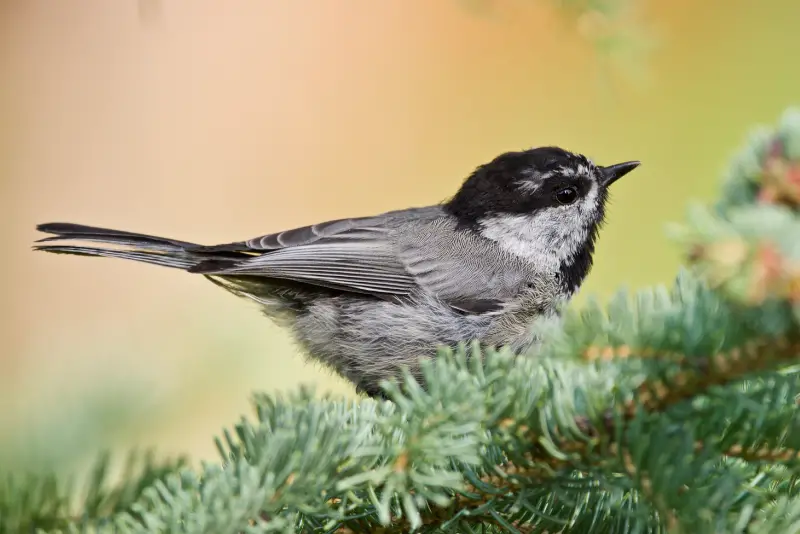
This small chickadee is a bird of the mountainous regions of the western United States, and often form part of mixed flocks of birds that roam around the forest.
The Mountain Chickadee is largely dark gray, except for its white cheeks, black hook, and black bib. It can also be recognized by its prominent white eyebrow stripe.
These birds are year-round residents in the western USA, and readily visit bird feeders that offer black oil sunflower seeds.
Bushtit
Scientific name: Psaltriparus minimus
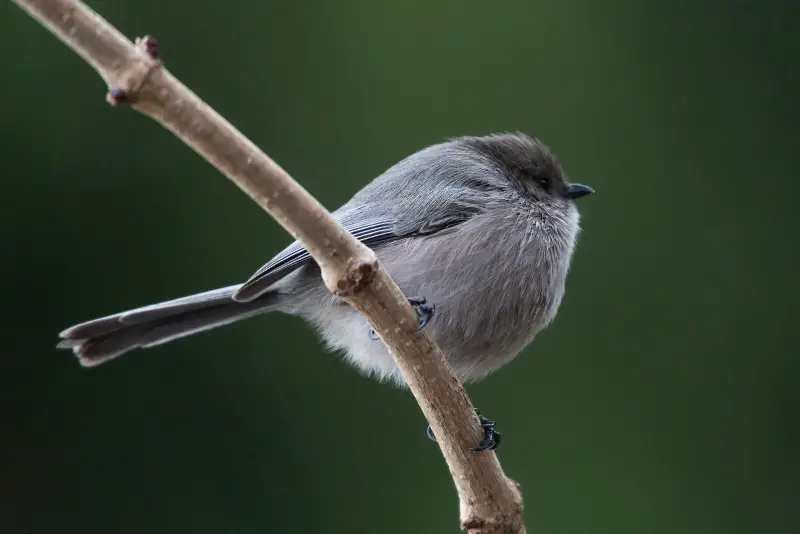
The Bushtit is another small songbird that is often encountered foraging in mixed flocks. It is almost entirely dark gray, except for its black beak and black eye.
While these birds are quite common within their range, they are easy to miss due to their small size, and because they forage mostly in the dense foliage of mature forests.
Bushtits are year-round residents of the southwestern United States, and also occur in Mexico and Central America.
Tufted Titmouse
Scientific name: Baeolophus bicolor
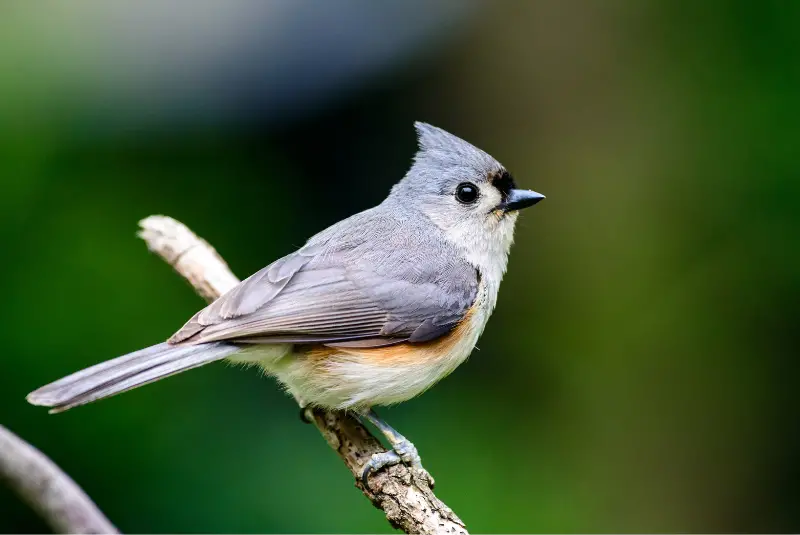
The Tufted Titmouse is a common and easily recognizable small songbird thanks to the distinctive crest on its head.
The sexes resemble each other, and have grayish-blue upperparts with a black forehead and a crest on the back of their head. The underparts are pale gray, but the flanks are tinged with buff orange.
It is a year-round resident in large parts of North America, and is readily observed, since it isn’t very shy. It is a regular visitor at backyard feeders, and also breeds in nestboxes.
It prefers deciduous forests, as well as parks and backyards, where it feeds on small
Black Phoebe
Scientific name: Sayornis nigricans

This bird is easily recognizable because of its striking black and grey and white coloration.
Adults males and females look similar, and have a sooty back, head and chest, which fades into dark gray towards the rump, and a white belly and under tail region.
Juveniles are broadly similar to adult birds but have brown feather fringes on their wings and back.
This bird is found in the southwestern United States, where it occurs all year round and can be easily observed because it is not afraid of people.invertebrates and seeds.
Eastern Phoebe
Scientific name: Sayornis phoebe

The Eastern Phoebe is a plump small flycatcher with mostly gray colored plumage. The wings are slightly darker with blackish primarie and two light gray wing bars.
Both sexes, as well as juveniles, look very similar and have buff white underparts. It hunts flying insects from a perch, and catches them in flight.
It is a bird of the eastern United States that can be encountered breeding in parks, backyards and woodlands.
Blue-gray Gnatcatcher
Scientific name: Polioptila caerulea
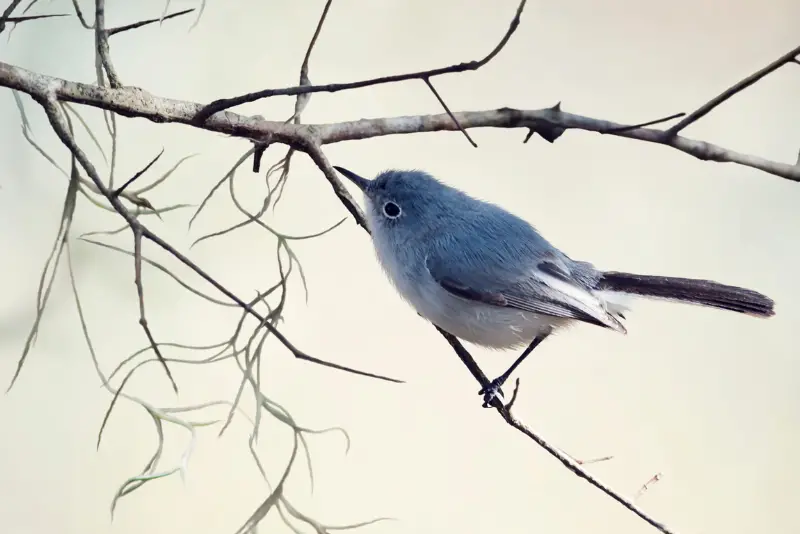
Except for its long tail, the Blue-gray Gnatcatcher looks a lot like a warbler.
The upperparts of adult males are blue-gray, while their underparts are a lighter gray. The black tail has white stripes at its margins.
Adult females and immatures are grayish on top, with light gray underparts, and both sexes have a white eyering.
The Blue-gray Gnatcatcher may be encountered as a breeding bird in the temperate regions of North America, predominantly from early May through August.
It is a partial migrant, with southeastern populations being year-round residents. Northern populations, however, spend the winter in the southern USA and Central America.
A great way to identify this small bird is by its long tail that is often pointed upwards.
Dark-eyed Junco
Scientific name: Junco hyemalis

Dark-eyed Juncos are small grey-colored sparrows that are common breeding birds in large parts of the United States.
Male juncos are dark grey on top with a white belly, while females and immature birds are duller and browner.
These small grey birds breed in coniferous as well as mixed forests across North America.
During winter they can be found in a variety of habitats, including backyards, forests, and meadows.
These birds feed on seeds which they pick up from the ground, and can be easily recognized by the high pitched sounds they make while foraging.
Black-throated Gray Warbler
Scientific name: Setophaga nigrescens
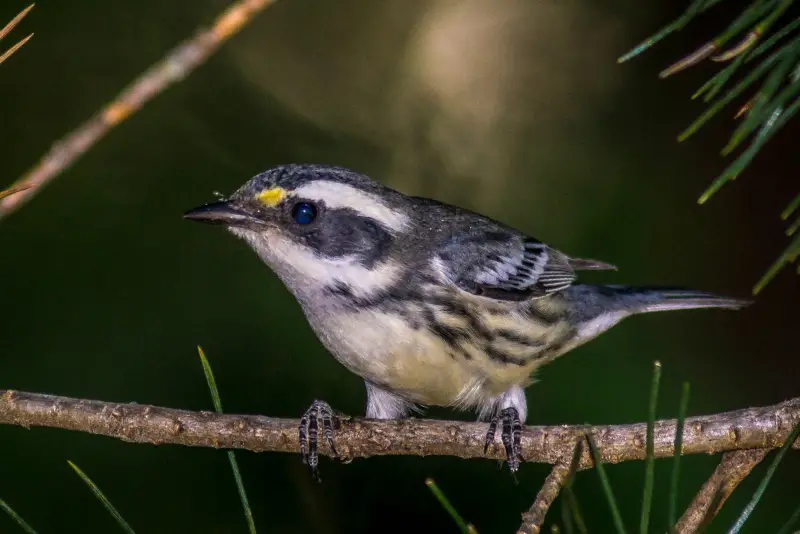
The male Black-throated Gray Warbler is a beautifully colored songbird with a dark gray back, a black-and-white head, a black throat, as well as a buff underside with dark stripes on its flanks.
Females are lighter than males, and are light gray on top and white on the bottom. They are birds of coniferous and mixed forests in the southwestern United States and the west coast.
These warblers are summer visitors that migrate south in September to spend the winter in Central America.
Loggerhead Shrike
Scientific name: Lanius ludovicianus
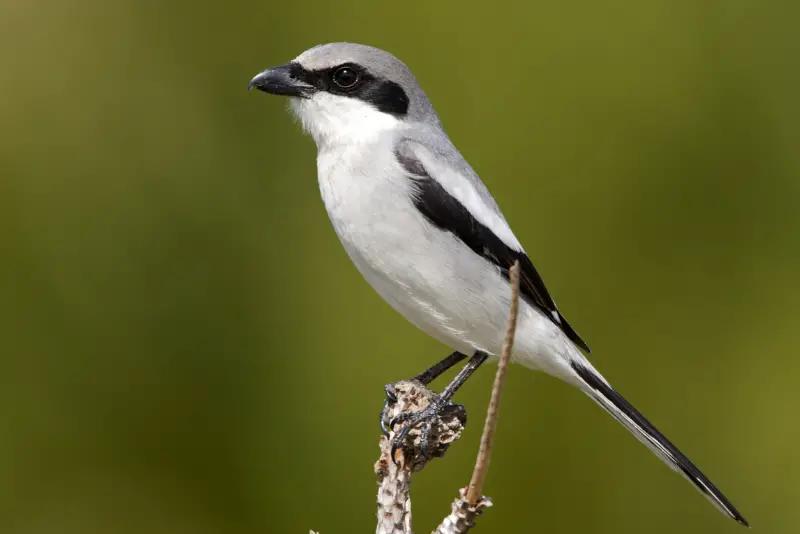
The Loggerhead is the only shrike species breeding in the United States, where it is encountered in open habitats, including grassland and scrub land.
Both sexes are similar and have a gray back and head, which contrasts with their black mask, wings, and tail, as well as a white throat and wing patch.
While these shrikes are songbirds, they behave like small raptors and hunt small vertebrates, such as lizards and rodents, as well as large insects in open grassland.
Eastern Kingbird
Scientific name: Tyrannus tyrannus

This large flycatcher has a dark gray upperside, with a black hood, rump and tail. The underside and throat are bright white.
Eastern Kingbirds are very aggressive towards other bird species, and even harass large species, such as hawks, herons, and crows that come near their nesting territory.
These birds are summer visitors throughout large parts of North America, being absent only from the southwest. They spend the winter in South America.
Final remarks
In summary, here are the 15 types of birds in North America that have a combination of grey and black feathers:
- Northern Mockingbird
- Gray Catbird
- White-breasted Nuthatch
- Carolina Chickadee
- Black-capped Chickadee
- Mountain Chickadee
- Bushtit
- Tufted Titmouse
- Black Phoebe
- Eastern Phoebe
- Blue-gray Gnatcatcher
- Dark-eyed Junco
- Black-throated Gray Warbler
- Loggerhead Shrike
- Eastern Kingbird
If you’ve spotted one of these birds while bird watching in your backyard, hopefully this ID guide will help you identify it quickly and easily.
And if you enjoyed this article, check out our guide to the different types of black birds.
